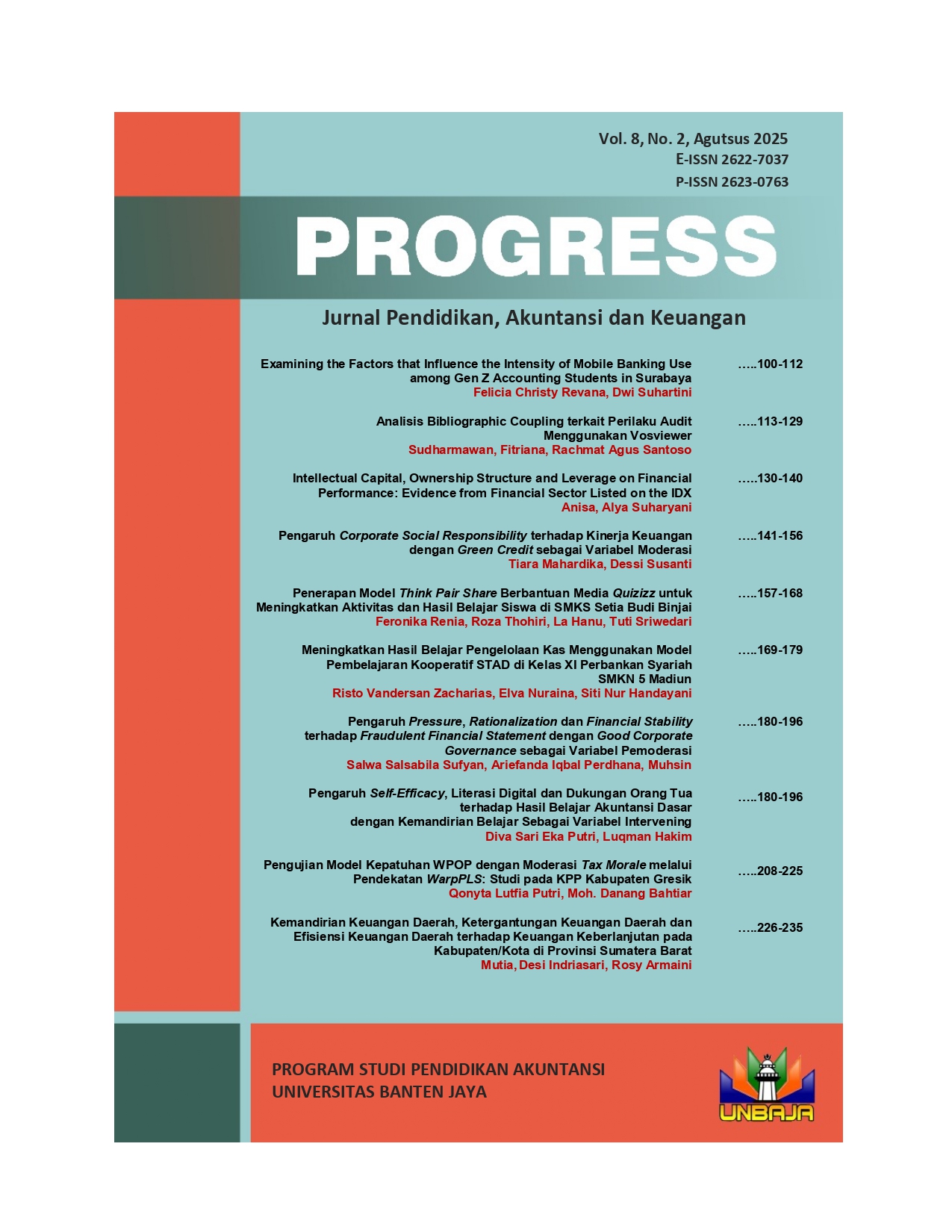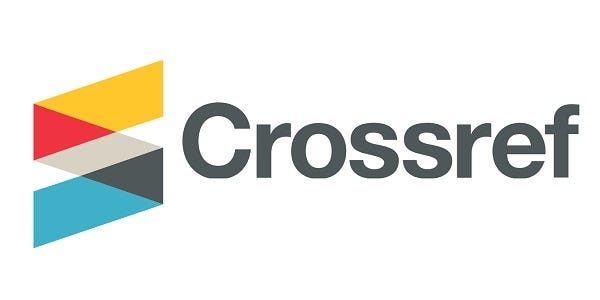Analisis Bibliographic Coupling terkait Perilaku Audit Menggunakan Vosviewer
DOI:
https://doi.org/10.47080/y2hves23Keywords:
Audit behavior, Bibliographic Coupling, VOSviewerAbstract
This study aims to explore trends and patterns in research of audit behavior research through a bibliographic coupling approach using VOSviewer software. Bibliographic couplings are used to measure similarities, such as shared citations. It happened when two works referenced the third work in their bibliography.This study also aims to find out the core journals in international publications, find out how many clusters of publication development and also want to find out how widely the spread of publications on this topic is around the world. This method enables the mapping of relationships between documents based on shared references, thereby identifying thematic clusters and conceptual connections within the literature. Bibliographic data were collected from reputable academic databases and analyzed to reveal the structure and dynamics of research development in the field of audit behavior. The visualization results show the formation of several dominant clusters representing thematic focuses such as auditor ethical pressure, independence, decision-making, and the influence of organizational culture on audit behavior. Key works such as Reynolds (2000), Chan (2012), and Coram (2004) emerge as foundational contributions that underpin subsequent studies. These findings offer valuable insights into the direction of research development and assist scholars in identifying gaps and potential collaborations within the domain of audit behavior.
References
Agus Santoso, R. (2022). Trends in Audit and Good Corporate Governance Research: A Bibliometric Analysis from 1994 to 2022 Based on Scopus Data. Golden Ratio of Data in Summary, 2(2), 97–106. https://doi.org/10.52970/grdis.v2i2.660
Amin, K., Eshleman, J. D., & Guo, P. (2021). Investor Sentiment, Misstatements, and Auditor Behavior *. Contemporary Accounting Research, 38(1), 483–517. https://doi.org/10.1111/1911-3846.12616
Boyle, E. S. (2024). How do auditors’ use of industry norms differentially impact management evaluations of audit quality under principles-based and rules-based accounting standards? Journal of International Accounting, Auditing and Taxation, 54, 100598. https://doi.org/10.1016/j.intaccaudtax.2024.100598
Che, L., Myllymäki, E.-R., & Svanström, T. (2023). Auditors’ self-assessment of engagement quality and the role of stakeholder priority. Accounting and Business Research, 53(3), 335–375. https://doi.org/10.1080/00014788.2021.2001638
Coram, P., Ng, J., & Woodliff, D. R. (2004). The Effect of Risk of Misstatement on the Propensity to Commit Reduced Audit Quality Acts under Time Budget Pressure. AUDITING: A Journal of Practice & Theory, 23(2), 159–167. https://doi.org/10.2308/aud.2004.23.2.159
Deng, Y., Hope, O., Wang, C., & Zhang, M. (2022). Capital market liberalization and auditors’ accounting adjustments: Evidence from a quasi‐experiment. Journal of Business Finance & Accounting, 49(1–2), 215–248. https://doi.org/10.1111/jbfa.12559
Dowling, C., & Leech, S. a. (2014). A Big 4 Firm’s Use of Information Technology to Control the Audit Process: How an Audit Support System is Changing Auditor Behavior. Contemporary Accounting Research, 31(1), 230–252. https://doi.org/10.1111/1911-3846.12010
Elevany Sera, D., & Agus Santoso, R. (2024). Penelitian Continuous Auditing Dan Monitoring Untuk Masa Depan Menggunakan Analisis Bibliometrik. https://doi.org/10.46306/rev.v4i2
Forsyth, denelson R. (1987). A taxonomy of ethical ideologies.
Gulo, N., Indra Nugraha, R., Natasya, A., Agus Santoso, R., Sangga Buana, U., & Tinggi Ilmu Ekonomi STAN, S. I. (2024). Edukatif: Jurnal Ilmu Pendidikan Pemetaan Bibliometrik terhadap Perkembangan Penelitian Kualitas Audit pada Scopus Menggunakan VOSviewer. Jurnal Ilmu Pendidikan, 6. https://doi.org/10.31004/edukatif.v6i6.7814
He, K., Pan, X., & Tian, G. (2017). Legal Liability, Government Intervention, and Auditor Behavior: Evidence from Structural Reform of Audit Firms in China. European Accounting Review, 26(1), 61–95. https://doi.org/10.1080/09638180.2015.1100547
Hermawan Madu, D., Agus Santoso, R., Tinggi Ekonomi STAN, S. I., & Rusdiansyah, N. (2024). Analisis Bibliometrik Tren Kolaborasi Penelitian antar Peneliti terkait dengan Audit Eksternal suatu Bisnis serta Instansi Pemerintah di Indonesia (Tahun 2018-2023). 6(1), 10–16.
Johansen, T. R., & Christoffersen, J. (2017). Performance Evaluations in Audit Firms: Evaluation Foci and Dysfunctional Behaviour. International Journal of Auditing, 21(1), 24–37. https://doi.org/10.1111/ijau.12079
Jurica Lucyanda. (2012). Faktor-Faktor Yang Memengaruhi Perilaku Etis Mahasiswa Akuntansi Universitas Bakrie.
Kuswara, Z., Pasaribu, M., Agus Santoso, R., Pascasarjana, F., Sangga Buana, U., & Tinggi Ilmu Ekonomi STAN, S. I. (2024). Exploring The Latest Internal Audit Trends: Bibliometric Study Based On Scopus Data 2020-2023.
Myers, L. A., Schmidt, J., & Wilkins, M. (2014). An investigation of recent changes in going concern reporting decisions among Big N and non-Big N auditors. Review of Quantitative Finance and Accounting, 43(1), 155–172. https://doi.org/10.1007/s11156-013-0368-6
Nehme, R., AlKhoury, C., & Alharbi, A. (2022). Stimulants of behavioural change: accounting education schism and gender. Accounting Research Journal, 35(5), 698–720. https://doi.org/10.1108/ARJ-05-2021-0145
Reynolds, J. K., & Francis, J. R. (2000). Does size matter? The influence of large clients on office-level auditor reporting decisions. Journal of Accounting and Economics, 30(3), 375–400. https://doi.org/10.1016/S0165-4101(01)00010-6
Serius Nazara, D., Fitriana, F., & Santoso, R. A. (2024). Analisis Bibliometrik Dengan Vosviewer Terhadap Perkembangan Penelitian Forensic Audit. https://doi.org/10.55338/saintek.v5i1.2339
Suandani, R., Dachlan, F., & Santoso, R. A. (2024). Deteksi Kecurangan Laporan Keuangan Dengan Bibliometrik.
Sulastri, & Agus Santoso, R. (2025). Jurnal Maneksi (Management Ekonomi Dan Akuntansi) Pemetaan Riset Global Tentang Pajak Digital: Analisis Bibliometrik Berdasarkan Data Scopus. https://doi.org/10.31959/jm.v14i2.3019
Svanberg, J., & Öhman, P. (2013). Auditors’ time pressure: does ethical culture support audit quality? Managerial Auditing Journal, 28(7), 572–591. https://doi.org/10.1108/MAJ-10-2012-0761
Tsui, J. S. L., & Gul, F. A. (1996). Auditors’ behaviour in an audit conflict situation: A research note on the role of locus of control and ethical reasoning. Accounting, Organizations and Society, 21(1), 41–51. https://doi.org/10.1016/0361-3682(95)00009-X
Weber, J., & Stefaniak, C. M. (2018). Using Undisclosed Time Budgets to Reduce the Magnitude of Auditors’ Underreporting of Chargeable Time. Behavioral Research in Accounting, 30(2), 95–108. https://doi.org/10.2308/bria-52101
Yulianti, Y., Zarkasyi, M. W., Suharman, H., & Soemantri, R. (2024). Effects of professional commitment, commitment to ethics, internal locus of control and emotional intelligence on the ability to detect fraud through reduced audit quality behaviors. Journal of Islamic Accounting and Business Research, 15(3), 385–401. https://doi.org/10.1108/JIABR-02-2021-0076






 Indexing Databases:
Indexing Databases:




